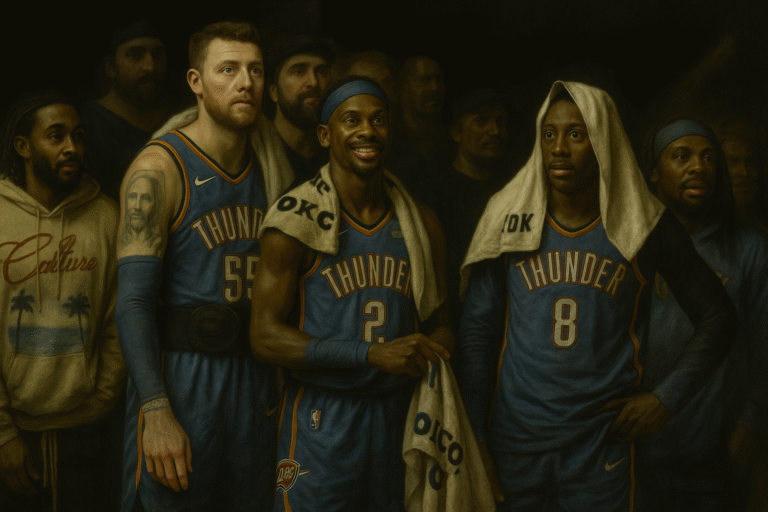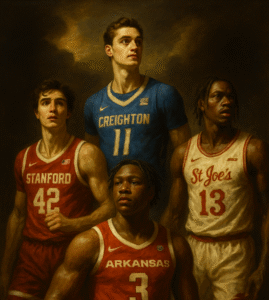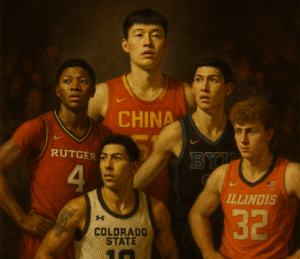005 // Time Is a Lie: Thunder-Pacers and the Death of the Window

//
Each July, thirty-two basketball executives successfully retain the only role with less job security than Love Island: NBA General Manager.
As a kid, no one was cooler than the Pat Riley godfather archetype: Armani suits, slicked-back hair, sloppy steaks. In 2025, I’m slightly less envious.
Under the previous CBA, the experience of running a team was somewhere between Oprah handing out cars and running a nightclub in the post-coke, pre-AIDS 80s. An era defined by post-cap spike market inflation, 7 first-round-pick mortgages, and Chandler Parsons max contracts.
GMs were given a multiple-choice question:
- Develop homegrown stars and beg them to stay
- Trade every first you own until the sun collapses into a black hole
- Spend 85% of the cap on your team’s Very Own Big Three
- Inception your owner into thinking the long tank was his idea
For years, the job was a choice: spend (to win, keep your job, or sell season tickets) or “build for later”. A binary fallacy concerned with championship windows, drafting for need, and debating if a 27-year-old is ‘simply too long in the tooth for our young core’.
Joey “Lightyears” Lacob infamously branded the Warriors’ exceptionality as ‘parallel timelines’. Despite Steph dragging them to a parade in 2022, that strategy* died on arrival. The media posturing was really a hedge, and it was always an illusion.
* See: Wiseman over Haliburton in ‘20, Kuminga over Franz in ‘21, or Jordan Poole overhand rights.
The window is dead. Success in the new CBA means optionality, flexibility, and readiness, not carefully mapped arcs or the illusion of control. Second-apron penalties and repeat-offender taxes have created a hard cap by another name. Even if your tech billionaire owner will swallow the luxury tax for stars A and B, the question becomes: can you still field defenders who won’t get played off the floor?
It’s no different than the NFL rookie QB contract window: the entire model hinges on extracting value before cost curves collapse flexibility. And transparency cuts both ways: that $60 million player looks a lot different when the repeater tax makes him a $200 million commitment.
For the first time in years, both Finals teams are positioned to own their conferences for the next five.
These days, the 2010s strategy of, say, buying a team and immediately sending out four unprotected firsts and handing Bradley Beal Juan Soto money (complete with a Scott Boras no-trade clause) is shockingly not a recipe for success.
For all the Sam Presti pick hoarding memes, he saw early the unwinnable power laws of mortgaging the future for the present. An unprecedentedly diversified stockpile of draft assets positioned them to benefit off the proliferation of power tanking at large. The intrapersonal skills to sway Paul George to OKC, then flip him for the war chest that seeded this roster.
And, perhaps most importantly, the patience to go all-in on rookie contracts, build the staff to develop them into stars, and resist the urge of choking the fire with a deadline move for a disgruntled max player.
Unlike many pseudo or one-off contenders, the Thunder are positioned to easily support their core for years, with no apron in sight. A full bench of young, egoless talent, with reinforcements like 19-year-old Nikola “Serbian Stockton” Topić still to see the floor.
This summer, they may very well pivot from Lu Dort, simply because his First Team All-Defense skillset is now expendable.
Indiana’s ascent reads more like the 2015 Warriors: a cheap, finally healthy roster, led by an ascendant superstar and playing at a backbreaking pace for a generational coach. Pulling off the Haliburton-Sabonis trade, giving him the keys and flooring it straight onto the Autobahn. A basketball philosophy best described by Marshawn Lynch:
“It clicked in my mind: if you just run through somebody’s face, a lot of people aren’t going to be able to take that, over and over and over and over and over and over and over and over and over and over and over and over and over again.”
Haliburton, the purest embodiment of the pass-first point guard since Steve Nash, defies the heliocentric playing style of most modern max contract guards. It’s like he watches White Chocolate and Gretzky highlights in the locker room.
Instead of spending 20 seconds ‘spacing the floor and watching James Harden deflate the ball, Haliburton’s teammates fly off screens, into passing lanes, and out in transition. If Harden is the Sun, Haliburton is more a nucleus, orbited by electrons at light speed. They run because, more often than not, the pass is already in the air.
Sure, Indiana has had the most statistically improbable comebacks in a single playoffs in league history. But it’s not dumb luck: the strategic optionality and fearless belief needed for those comebacks can only exist with a bench deep with players with the skills to add value, buy-in from the coaching staff, and the regular-season reps necessary to contribute deep into a series.
For the opposite effect, see the Knicks: Thibs played his starters 87 minutes a game during the season and didn’t attempt to pivot until the Conference Finals. As of this week, Thibs has been relieved of his services.
The realities of teambuilding in 2025 extend well beyond this Finals matchup. Milwaukee is set to trade its best player in history and doesn’t own a first-round pick until 2031. Philadelphia will be paying Joel Embiid 69 million US dollars in 2029. Mat Ishbia may be violating UN law by subjecting every Phoenix-area TV to Suns basketball.
Inflated max contracts from CBAs past continue to haunt the league like specters. If you don’t like jumpscares, don’t even look at Tobias Harris’s Spotrac. No one’s immune: even darlings like the Nuggets and Wolves will soon have to face the music. Even the best-run teams know: the race is no longer to build a window, but to build leverage.
The 2024 Celtics may be the end of an era. The last quote-unquote superteam that won (although their path to the title is a … different conversation). The Steve Ballmer line item that is the Los Angeles Clippers may have even been OKC’s best match in the West this year. But those are short spikes – all-in shoves by GMs who know if it goes wrong, at least they won’t be in charge when the picks roll around.
To win, building sustainably now looks different. Trading five firsts for a second star doesn’t just bet the farm on the future, it handicaps your very ability to deliver on the bet you waged your job on. Look at the league’s macro trends: more games, more physicality, more parity all season long. Teams with the depth to stay healthy, optionality to win multiple ways, and the roster flexibility to address personnel weaknesses are what the league requires.
In this league, time used to be a weapon — you built for it, capitalized on your peak, and sold your owner on ‘the window.’ Not anymore. The new NBA punishes the rigid, the heavy, the all-in. In a league of compounding penalties and compounding chaos, the only surviving laws are power laws. The smartest teams aren’t building around time. They’re building engines that don’t stop.
//
Related Posts

2025 NBA Draft Tiers: Day 2 Guide
The second round of the NBA Draft often gets overshadowed by the lottery and big trades, but this is where savvy front offices find value. The top is loaded with high-floor role players, project bigs, and overlooked international prospects who can outperform their draft slot.

2025 NBA Draft Breakdown: First Round Recap & Analysis
The 2025 NBA Draft largely validated pre-draft consensus as most of the top selections fell within projected ranges. Teams prioritized two-way versatility, shotmaking, and players with high upside. Still, there were notable deviations that highlighted how individual team context continues to shape draft strategy more than media boards or aggregated mock drafts.
